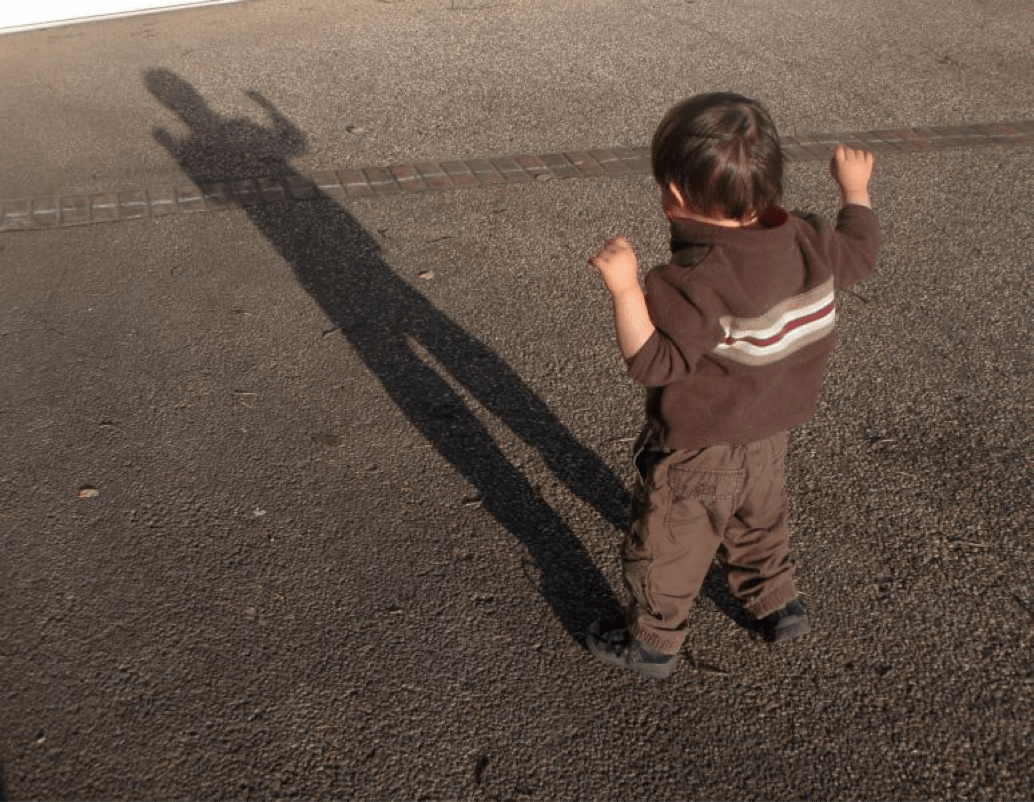
Discuss: What are the two different ways you could make the shadow move?
Reveal answer
(1) You can make the shadow move by moving the flashlight while holding the balloon still. Or, (2) you can make the shadow move by keeping the flashlight still while turning the balloon.

When you are playing outside on a sunny day sometimes you notice your shadow and it is short, and other times you notice your shadow and it’s long like this picture.
Discuss: What time of day is your shadow long? (Morning, noon, or afternoon?)
Reveal answer
Your shadow is long in the morning soon after the Sun rises, it’s shortest when the Sun is directly over your head at noon, and then your shadow is really long again in the late afternoon just before the Sun sets.

Discuss: What do you think is true: is the Earth turning? Or is the Sun going around us?
Reveal answer
You may have heard adults tell you that the Sun doesn’t go around us, that it’s the Earth that’s spinning. But now that we’ve seen this with the balloon, you can’t be so sure.
Let’s watch the next video for some help.

Discuss: How could you figure out for sure whether it's the Earth or the Sun that's moving?
Hint: Think about the train.
Reveal answer
Just like you could get off the train to find out which one was moving, you could get off the Earth--go into space!

Discuss: Say we have a big globe and a flashlight. How could we figure out what a tiny person on the globe would see, as the globe turns?
Reveal answer
See the next video!

Call students’ attention to the movement of shadows by marking the position of a shadow cast by the Sun. Ask your students to guess (and mark) where the shadow will be in ten minutes. To mark a shadow, use chalk (if you're on the playground) or a post-it (if the shadow is in the classroom).
Students might be surprised at how much a shadow moves in 10 minutes. They can also have fun competing against each other with their guesses.
You can have students trace their shadows on the playground in the morning, at midday, and in the afternoon. Like Post-It Paula's shadow on the balloon, your shadow will change with the angle of the Sun (long in the morning, short at midday, and back to long in the evening). Students will enjoy seeing their silhouette get morphed and skewed.
For a detailed description of this activity, check out the National Science Teacher’s Association Changing Shadows.
In this Mystery, students will realize that the setting Sun isn’t moving, the Earth is spinning!
Preview activityStudents will work in pairs. Each pair of students will need:
a sunny day*
*It's only the very last step of the activity where students need to go outside and experiment with the Sun. If it's not sunny on the day you want to do this activity, you can instead ask each student holding the flashlight to remain still while the other student turns the balloon. In other words, you want to guide the kids to see that when they're outside, they have to turn the globe rather than move the flashlight (because they can't move the Sun). The difference is not as dramatic for the kids when you do it this way, so you should repeat this last step outside when it's sunny again.
Thanks for your feedback! If you have a question or need help, please contact us. Please consider sharing your review:
Sorry the lesson didn’t go well. We read every single review in an effort to improve our Mysteries.
Thanks for letting us know. We’ll wait to ask you for feedback until after you've actually taught it.
Thanks for the feedback! We read every single review in an effort to improve our Mysteries.
Please follow these steps:
Locked
6:10

Why is the sky blue?
Locked
4:41

Why do we call them doughnuts?
Locked
5:16

Could a turtle live outside its shell?
Your membership is expired. The archive of past Mini Lessons is not included in your limited access.
View pricing